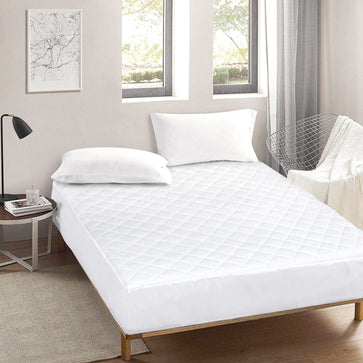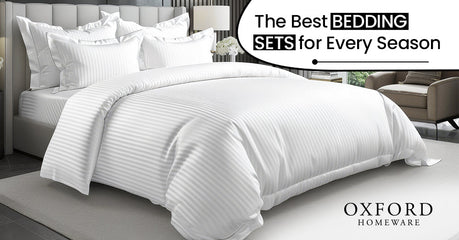Say Goodbye To Stains And Allergens With A Quality Mattress Protector
Any home must invest in a mattress protector. Your mattress is protected against spills, allergens, and stains and kept hygienic and clean. This blog article will discuss the advantages of using a high-quality mattress protector and how to choose the best one for your requirements.
Why Is A Mattress Protector Important?
A mattress cover separates your body and the mattress. It lessens the possibility of stains and odours by preventing sweat, skin cells, and other physiological fluids from penetrating the mattress. A mattress protector protects against allergens, including dust mites, pet dander, and mould.
Benefits Of Using A Mattress Protector
Anyone who wishes to preserve the durability and quality of their mattress should make a mattress protector investment. Numerous advantages of using a high-quality mattress protector include obtaining a good night's sleep and enhancing your general health and well-being.

Safeguards Against Stains And Spills
A terry mattress protector adds a layer of defence against spills, stains, and other mishaps that might harm your mattress is one of the essential advantages of utilising one. A mattress protector may stop liquids from seeping into your mattress, keeping it clean and sanitary, whether a drink spill or a bedwetting disaster.
Protection Against Allergens
Dust mites, bed bugs, and other allergens may be stopped from entering your mattress and reducing the quality of your sleep using mattress coverings. Having a decent night's sleep is challenging because of allergies, asthma, and other respiratory issues that these slight irritants may bring on. By putting up a barrier between your mattress and allergens with a mattress protector, you can ensure a cleaner and healthier sleeping environment.
Lengthens Mattress Life
Since a mattress is expensive, you want it to endure as long as possible. By avoiding damage brought on by spills, stains, and allergies, using a mattress protector may help your mattress last longer. You may save money in the long term by preventing your mattress from being damaged by these things by preventing the need to replace it as often.
Boosts The Quality Of Sleep
Better sleep quality may be achieved by fostering a cleaner and healthier sleeping environment with a Extra Deep Quilted Mattress Protector. Sleep on a clean and sanitary surface makes you less likely to wake up with allergies, skin irritation, or other health issues. If your bedroom is cosy and tidy, you may sleep better, remain asleep longer, and feel rejuvenated and energetic.

Reduced Allergens
Materials created expressly to decrease allergies may be used to make mattress protectors. For those who have allergies or respiratory issues, this is highly beneficial. Allergens, including dust mites, mildew, and bacteria, cannot flourish in items using allergen-resistant materials. You may breathe more easily and sleep more soundly by eliminating allergies.
Also check: Have You Installed a Mattress Protector
Types Of Mattress Protectors
Mattress protectors come in a variety of designs to meet your specific requirements. These consist of the following:
- Waterproof mattress protectors: Waterproof Mattress protectors are excellent for homes with small children or animals. They shield your mattress from spills and mishaps, keeping it sanitary and tidy.
- Allergen-resistant mattress protectors: For anyone with allergies or asthma, allergen-resistant mattress coverings are ideal. They act as a barrier against dust mites, cat dander, and other allergies to ensure a peaceful night's sleep.
- Cooling mattress protectors: These are excellent for those who often experience heated sleep. They use state-of-the-art cooling technology to keep their body temperature comfortable as they sleep.
- Cotton mattress protectors are the best for those who want something breathable and natural. They are plush and inviting, giving a good night's sleep.
Considerations For Choosing A Mattress Protector
With so many mattress protector alternatives, it might take time to choose the best one. When choosing a mattress protector, keep the following things in mind:
Fit And Size
When picking a mattress protector, the size and fit are crucial. Ensure the protector is an excellent fit for your mattress, with no slack or tight spots. Select a protector based on the measurements of your mattress. Most protectors are available in UK standard sizes such as single, double, king, and super king.
Materials And Construction
The material and structure may influence the mattress protector's longevity, breathability, and comfort. Choose protectors constructed from premium fabrics like cotton, bamboo, or microfiber. The structure must be robust and solid to guarantee that it can resist frequent usage and cleaning. Additional properties like waterproofing, cooling, or allergy resistance are also included with specific protectors.
Price
A mattress protector's brand, quality, and features might affect its cost. Set a spending limit for yourself and hunt for protectors inside it. Remember that a more significant price does not necessarily equate to better quality, so do your research before buying by reading reviews and comparing pricing.
Warranty
Thanks to the mattress protector's guarantee, you may feel secure knowing you are shielded from potential flaws or problems. Ensure you comprehend the guarantee's terms and circumstances and look for protectors with at least a one-year warranty.
You should consider these things while choosing a mattress protector that meets your needs and preferences. A suitable mattress protector can preserve your mattress, enhance the quality of your sleep, and create a cleaner, healthier sleeping environment.
How To Install A Mattress Protector Correctly?
The method of installing a mattress protector is simple and uncomplicated.
- Remove your mattress's linens, including the sheets and pillowcases.
- The mattress protector should be unpacked and opened.
- Ensure the protector is centred and covers the mattress entirely before placing it on top.
- Make sure the protector's corners line up with the corners of your mattress by checking them.
- The protector is kept in place by tucking the elasticised edges of the protector beneath the mattress. Ensure the mattress protector covers the mattress smoothly, without any creases or bulges.
- When the protector is firmly positioned, your sheets, duvet, and pillows should be added as usual.

Some mattress covers could have additional guidelines or restrictions, such as the need to let them air out or be washed before use. To ensure you follow the manufacturer's suggestions, read the directions included with your protection.
Correctly applying a mattress protector requires your mattress to be protected, kept clean, and healthy. You can ensure that your protection is appropriately placed and that you can take advantage of all its advantages by following these instructions.
The Environmental Impact Of Mattress Protectors
As we grow more conscious of how our everyday activities affect the environment, it is crucial to consider how the items we use, like mattress protectors, affect the environment. Here are some ideas for minimising mattress protectors' adverse environmental effects:
- Environmentally friendly Options: Look for mattress protectors made of environmentally friendly materials like organic cotton, bamboo, or Tencel. These materials are better for the planet since they biodegrade and don't need harmful fertilisers and pesticides during cultivation.
- Options for recycling: Instead of tossing away your old mattress cover when it's time to replace it, think about recycling it. Some manufacturers provide recycling services for their goods, enabling you to return your used protector to them for appropriate recycling.
- Recycling: Repurposing your old mattress protector is another option to save waste. It may be used to construct pet beds, cleaning rags, or even a waterproof protector for patio furniture.
- Longevity: By selecting a high-quality mattress cover, you may increase the lifespan of your mattress, minimising the need for frequent replacements and the associated environmental effect.
- Avoid extra features: Some mattress protectors include extra functions that may only be essential for some, like waterproofing or cooling. Removing unneeded features may lessen the manufacturing process's adverse environmental effects.
You may lessen the environmental effect of mattress protectors by selecting sustainable choices, recycling or upcycling existing protectors, and prolonging the lifespan of your mattress. These little efforts may add up to a significant impact on protecting our world for future generations.
Mattress Toppers Vs Mattress Protectors
Although popular bedroom accessories, mattress guards and mattress toppers have distinct functions, here are the main distinctions between them and the appropriate times to employ each:

Function
Your mattress will be shielded from spills, stains, and allergies with a mattress protector. It is often constructed of waterproof or allergen-resistant materials and is thin. A mattress topper, on the contrary hand, is meant to enhance the softness and durability of your bed. It is constructed of materials like memory foam or latex and is thicker than a mattress protector.
Thickness
Since they are often thinner than mattress toppers, mattress protectors blend better with your mattress. Mattress toppers are thicker and might alter the way your mattress feels overall.
Price
Generally speaking, mattress coverings are less costly than mattress toppers. Your choice of material and thickness will affect the price of a mattress topper.
When to use each: Mattress toppers and protectors have distinct purposes and are made with different demands in mind. Protect your mattress from dust mites, allergens, and spills with a mattress protector. Use a mattress topper if you want more comfort and support from your mattress. A mattress protector and a mattress topper may be used together to provide superior protection and comfort for your mattress.
How To Care For And Clean Your Mattress Protector?
Your mattress protector must be cleaned and cared for for optimum quality and endurance. The following advice will help you clean, dry, and preserve your mattress protector:
Washing Guidelines
- Before washing your mattress cover, consult the manufacturer's instructions.
- Most mattress protectors may be cleaned in a washing machine using mild detergent and either warm or cold water.
- Avoid using fabric softeners or bleach since they might harm the fabric and lessen the power of the protection.
- Before cleaning the whole mattress protector, spot-clean the soiled area with water and mild detergent.
Drying Guidelines
- After laundering, let your mattress protector air dry or dry it in a low-heat dryer.
- High heat settings should be avoided since they might shrink the protection and harm the cloth.
- If you must iron your mattress protector, use a low heat setting on the fabric's backside.
Maintenance Tips
- Wash your mattress protector often to eliminate sweat, grime, and other particles that might assemble over time.
- Use a mattress pad or topper over your mattress protector to provide an additional layer of defence and help the protector last longer.
- Avoid eating or drinking in bed to avoid spills and stains on the protector.
- If you have animals, keep their nails cut so they won't rip or puncture the cover.
- Replace your mattress protector when it shows signs of wear or damage to keep your mattress safe.
Mattress Protector Alternatives
Here are a few alternatives to deep mattress protectors that you may want to take into account:
Fitted Sheets
Fitted sheets may aid in preventing sweat, dust, and filth from damaging your mattress. To keep your bed clean and fresh, they are simple to wash and may be replaced often. To prevent spills and stains, they could not be as effective as a specialist mattress cover and might not provide as much protection.
Mattress Pads
Mattress pads provide greater comfort for your mattress since they are thicker than fitted sheets. They may also provide some defence against stains and spills. Some mattress protectors are waterproof, which is advantageous if you have kids or pets. Like fitted sheets, they could provide a different level of security than a specialist mattress protector.
Also read: Why Do You Need A Mattress Protector For This Christmas Festive
Comforters
If you don't have a mattress cover or another option, you may use comforters as a temporary fix, even though they aren't intended to protect your mattress. All you have to do is spread the comforter over your mattress and tuck the edges in.
But remember that while comforters are not meant to be cleaned as regularly as sheets or mattress covers, they may only sometimes be as sanitary.
Conclusion
Utilising a mattress protector is a crucial investment that has several advantages. A good mattress protector may prolong the life of your mattress, shield it against allergies, prevent spills and stains, enhance sleep quality, and reduce allergens.
When selecting a mattress protector, consider size and fit, material and construction, cost, and warranty. You can guarantee a spotless, sanitary, and pleasant sleeping environment by utilising a mattress protector.
FAQs
How frequently should a mattress protector be changed?
Depending on its quality and use, changing your mattress protector every two to three years is advised. The protector's ability to safeguard your mattress may diminish with time and gather sweat, grime, and other impurities impairing its functionality.
Does a mattress protector provide bed insect defence?
Certain mattress coverings have particular components and structures to keep bed bugs from entering or leaving your mattress. If bed bugs worry you, look for coverings mainly promoted as bedbug-proof.
Can a mattress protector protect against bed bugs?
As long as the mattress protector is constructed of hypoallergenic materials and is routinely cleaned to eliminate allergens like dust mites and pet dander, it is unlikely to induce allergies. However, it's critical to verify the ingredients used in the protection to ensure they won't trigger any allergies or sensitivities if you have any particular ones.
Can you wash a mattress protector in the washing machine?
Yes, you may wash most mattress covers in a washing machine with a gentle detergent and tumble dry them on low heat. To make sure you're cleaning it properly and avoiding any items or methods that might harm it, it's vital to read the care label on your particular protector.




